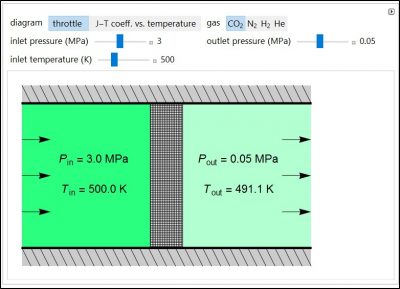Throttling and Joule-Thomson Expansion: Interactive Simulations
These simulations were prepared using Mathematica. Download the free Wolfram player, and then download the simulation CDF file (link given below or click on figure to download). Try to predict the behavior when a parameter changes before using a slider to change that parameter. For these simulations, screencasts are provided to explain how to use them.
When a gas expands through an adiabatic throttle (often a porous plug), the temperature can change as a result of the Joule–Thomson effect. You can select one of four gases, and use sliders to adjust the inlet temperature, inlet pressure, and outlet pressure. The intensity of the green color is proportional to the gas density, and the throttle is thicker for a larger pressure drop. Select “J-T coeff. vs. temperature” to see the Joule–Thomson coefficient plotted as a function of temperature.
Try to answer these questions before determining the answer with the simulation. We suggest that you write down the reasons for your answers.
- Carbon dioxide is fed to a throttle. How does the outlet temperature change when the inlet temperature increases? How does it change when the inlet pressure increases?
- Which gas has a larger temperature decrease when fed at high pressure to a Joule-Thomson expansion valve: CO2 or N2?
Water at high pressure expands adiabatically to a lower pressure (throttled) through a partially-closed valve. You can vary the inlet temperature \(T_1\) and outlet pressure \(P_2\). The exit stream is a vapor-liquid mixture, and the outlet temperature is the saturation temperature at the outlet pressure. An energy balance \((\Delta H = 0)\) determines the fractions of liquid and vapor in the exit stream, and they are shown in the bar graph.
Try to answer these questions before determining the answer with the simulation. We suggest that you write down the reasons for your answers.
- A compressed liquid is fed to a throttle. When the inlet temperature of the liquid increases, do the liquid and vapor fractions exiting the throttle change? If so, how and why?
- A compressed liquid is fed to a throttle. What happens to liquid and vapor fractions exiting the throttle when the outlet pressure increases.

